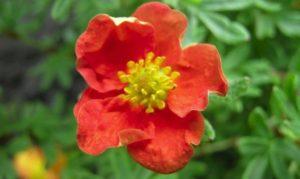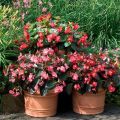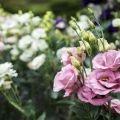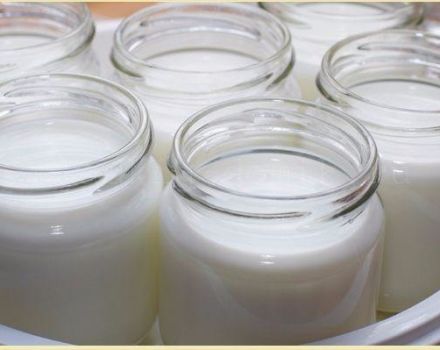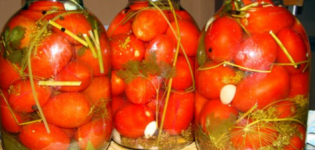Planting, growing and caring for garden begonia outdoors
An ornamental plant is found in the tropical forests of Africa and Asia, but it was brought to Europe from South America; the flower owes its name to Governor Begon from the island of Haiti. For a long time, an exotic guest grew up in greenhouses and in heated greenhouses, decorated apartment windowsills. Breeders have developed varieties of garden begonias for planting in open ground. Caring for a tropical guest does not raise many questions, and if you believe the legends, an amazing flower brings happiness and good luck to the owners.
Content
Features and description of garden begonia
At home, a perennial shrub does not take root in the ground, but is fixed on the trunks of trees. In the spring, the whole plant becomes covered with buds and blooms without ceasing for six months. Street begonia reproduces tubers, has a small height, has a bushy shape, attractive leaves are like hearts.
Flowers of a tropical guest delight with bright and colorful shades, there are:
- white and yellow;
- burgundy and pink;
- orange and peach.
The root of the plant is large and massive. In response to care, proper care of the miniature shrub responds with long and abundant flowering.
Subtypes of culture
Breeders based on the South American guest have created a thousand varietal begonias, and several double or simple plants planted in a flower bed give it an exquisite and elegant look. In the open field, unfortunately, not all varieties of ornamental crops take root, the color range of which is simply amazing.
Tuberous
Begonia forms a bush that grows up to 30 cm in height and is covered with large double buds of all kinds of shades. In some varieties, flowers resemble a lotus, in others - a rose or a carnation. Among this type of begonias, the Prima Donna is bred in the gardens, the Golden Ball is popular.

Eternal blooming
Miniature bushes that barely grow up to 15 cm are planted in parks and squares. They have smooth small leaves of a rich shade. During the growing season, begonia is covered with pink, snow-white, red "caps" of flowers.
Ampelny
One of the varieties of an ornamental plant has long shoots that spread along the ground. The bushes are literally dotted with small flowers of various bright colors. A very beautiful and elegant hedge is obtained from an ampelous plant.
Necessary conditions for growing
Begonia is a contented fastidious culture, it is not always accepted even in the room, it often does not please with abundant flowering, it is affected by insects. To grow a tropical guest in the garden, you need to create optimal conditions for it, irrigate and feed it on time.
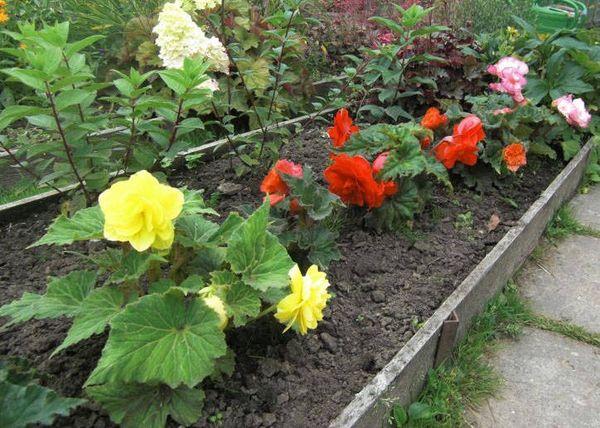
Air humidity
Begonia must be watered correctly so that the roots do not start to rot, drops do not fall on the leaves. In the garden, a place for a flower must be selected where groundwater does not approach the surface, or a drainage layer must be made. A tropical plant does not tolerate dry air, it requires constant moisture.
Temperature regime
Begonia comes from warm regions and does not withstand the cold, but in extreme heat it drops its buds. The ornamental culture pleases with abundant flowering at 18-22 ° C during the day, at least 16 at night, but in summer the plant adapts to higher temperatures.
Required soil composition
Begonia has weak roots, so that it grows well, the earth must be loose and light, not retain moisture, and let air pass through. The flower loves acidic soil with a pH of 5.4 to 6.5. For the outflow of excess liquid, expanded clay or crushed gravel is poured under the plant. The southern guest does not tolerate tannins.
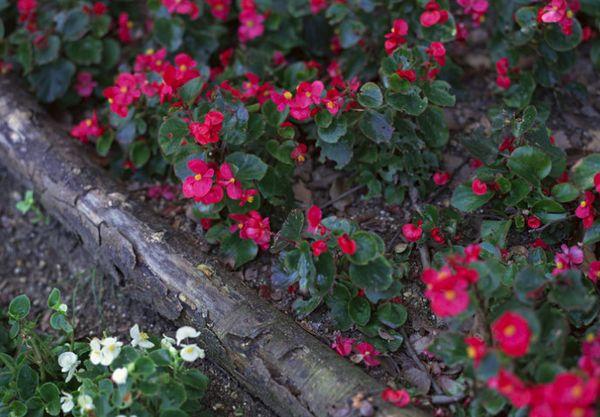
Location selection and lighting
Begonia does not like heat, and in the south it is recommended to plant it not in an area where direct sunlight falls, but in partial shade. In mid-latitudes for a tuberous flower, you need to select a well-lit place, closed from drafts and northern winds.
Planting begonias
If the flower is placed in the garden or in the flowerbed every 20 cm, you get an amazing carpet. The holes are filled with compost and peat, or a mineral complex containing phosphorus and potassium is poured. Begonia is watered and covered with sawdust or expanded clay, so that the moisture evaporates less. It is necessary to grow an ornamental culture in a seedling way, when leaves appear, which happens after a week, you can move it to a flower bed in open ground.
When to plant
Begonia dies with slight frosts, which in middle latitudes continue until the end of May, and in Siberia - until the beginning of June. A decorative flower is planted when the weather is warm and the cold should not return. You can send a plant to a flower bed in April and even in March, but cover it with a special material.
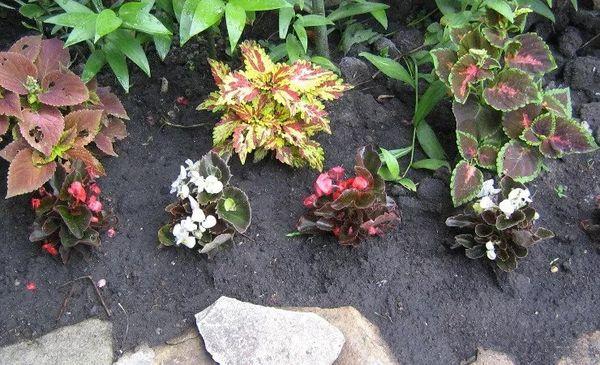
Soil preparation
The site for planting begonias is dug up, freed from weeds, stones, debris, river sand, peat and humus are added. Fertilizers can be applied directly during planting into the holes.
Combination with other plants
In landscape compositions, begonia is planted next to ornamental shrubs and flowers, a tropical guest is combined with Iberis, Surfinia, Petunia or Lobularia, which also bloom until the end of the season.
Planting technology
Begonia is propagated by leaf and stem cuttings, by dividing the tubers, but you can breed a decorative culture yourself in another way.
Seeds
To grow a healthy flower, you need to purchase seeds from a specialized store. Small grains collected in the current year are planted in containers or boxes. Larger seeds are placed in peat tablets.
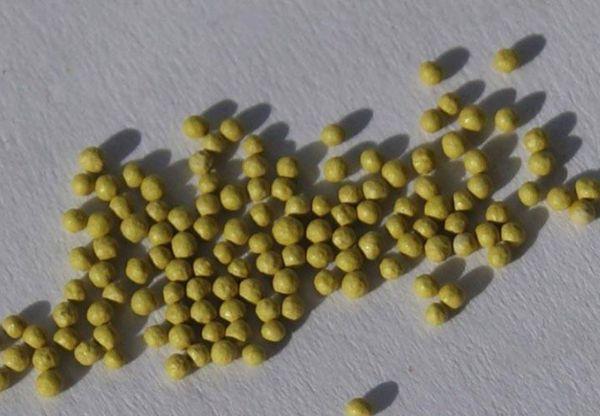
The ever-flowering begonia is sown in February, and the tuberous begonia is sown from January to April. By spring, the seedlings will have strong roots, and they will quickly adapt to new conditions.
Cuttings and shoots
For planting begonias, seeds are rarely used, since this method takes a long time to germinate.Planting with cuttings allows you to preserve the characteristics of the variety, the whole process consists of:
- from cutting the stems;
- drying;
- rooting;
- placement in the ground.
The features of the mother specimen are not lost when planting a part of the leaf or its cutting, but the plant in this case develops slowly.
Care and cultivation of crops in the open field
Having planted begonia on the street, you need to carefully look after it, make sure that the rays of the sun do not burn the leaves.

Irrigation frequency
It is recommended to water the ornamental plant every three days, more often in the heat. Soft water is used to moisten the soil; you can make it by adding a spoonful of vinegar to a bucket of liquid. Suitable for watering a mineral water flower. It is not necessary to spray the leaves, otherwise brown spots appear on them.
To make the moisture evaporate less, they pull out weeds, loosen the earth, sprinkle the soil near the bush with peat or sawdust.
Fertilization
In order for begonia to please with lush flowering, in the spring the plant is fed with a universal complex. In summer, the culture needs more phosphorus and potassium than nitrogen. Fertilize a tropical guest once every 2 weeks.
Bush formation
When the begonia grows to 60 mm, the top is shortened at an angle and the amount of watering is reduced. The flower lets out lateral shoots, if their length reaches 10 cm, cut off the top above the bud, which is located on the outside. Be sure to remove dried twigs and leaves.
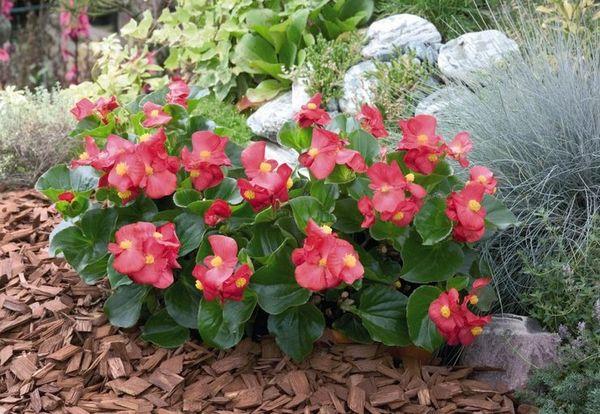
Potted outdoor begonia wintering
Young plant tubers in October are dug up together with a clod of earth and placed in a container filled with peat. The leaves and stems of an annual flower often continue to turn green. Potted begonia is placed in a cool but bright room and is rarely watered. In April, the plant is transplanted into a container with peat, and closer to summer - into a flower bed.
In the second year, the top of the flower is cut off by autumn, as it dies off.
Hibernates in apartment conditions
With the onset of October, the southern guest is watered less often. The entire ground part of the ornamental plant is shortened almost to the base, the pot is moved to a room where the temperature is not higher than 15 ° C. Begonia winters well in an insulated loggia, in a pantry, in a bath. Occasionally, the earth is moistened so that it does not dry out.
Storing tubers in an apartment
Begonia growing in a garden or in a flower bed is dug out before the onset of frost. The upper part of the flower is cut to a hemp, the tubers are dried in a dry and cool place, which are then folded into a box with sand and sawdust and left in the apartment.
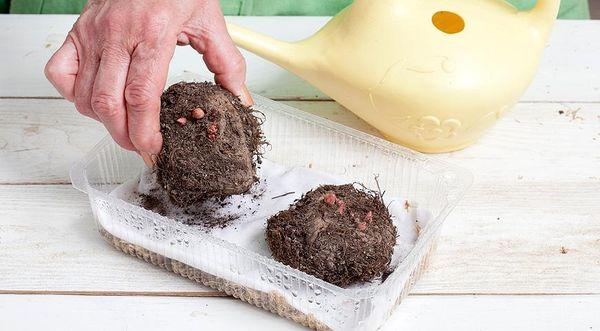
Begonia root can be stored in the refrigerator by packing in a plastic bag, puncturing holes in it, or simply wrapping it in paper.
In the basement
Dried flower tubers are laid out in boxes and boxes, covered with sand or peat mixed with sawdust. The containers are not taken to the cellar, where it is very humid, but placed in the basement.
Dangerous diseases and pests: control methods
Delicate and beautiful begonia growing in the garden or on the street attracts insects and pathogenic microorganisms, which is why it loses its sophistication, shedding buds and flowers.
Powdery mildew
In damp and cool weather, whitish spots appear on the stems and leaves of a tropical guest, which quickly spread throughout the plant. To cope with powdery mildew, the aerial part of the flower is sprayed with a fungicide.
Gray rot
With excess moisture, the microscopic fungus forms spores that are carried by the wind. Watery spots appear on the leaves, buds, stems of an ornamental plant, turning into gray rot. To save begonia, a solution is prepared by mixing several fungicides.

Aphid
Larvae and adult microscopic insects of yellow or green color do great harm to plants, feeding on their sap. If aphids start on begonias:
- Leaves turn yellow and dry.
- The buds do not bloom.
- Flowers are showered.
To cope with the pest, a solution of soap and tobacco dust is prepared, the bushes are sprayed with infusion of onion husks, poured with water and ash, and powdered with ash. Insects die when plants are treated with Actellik and benzophosphate.
Spider mite
At high air temperatures, combined with excessive watering, holes appear on the underside of the begonia leaves, which quickly increase in size, which indicates an infection with a spider mite. To save the flower, the ground part is sprayed with Decis or the biological pesticide Peretrium.
How to propagate begonia
To breed a tropical beauty, different parts of the plant are used. The flower is well accepted by green cuttings, it develops for a long time from the shoots.

Tubers
The propagation method is used when a rare flower needs to be preserved. A part separated from the begonia tuber is planted in a greenhouse or greenhouse structure. When a sprout appears, watering is done using a spray.
Cuttings
From a strong bush, the top with 6 leaves is carefully cut off, treated with the Kornevin stimulator, flowers and buds are cut off so that they do not take away the strength from the plant.
The stalk is planted to a depth of 5 mm in a mixture of sand and peat, covered with a jar, plastic, bag, or placed in a glass of water, where a spoonful of honey and aloe juice is added. Days after 10 days, the shoot sprouts.
Seed method
You can breed begonias using small grains harvested this year. But this process of reproduction takes a long time, and seedlings from seeds do not always appear. The sprouts are very delicate and fragile, they are kept in the apartment for almost a year, until the bushes are formed, which can already be transplanted into open ground.
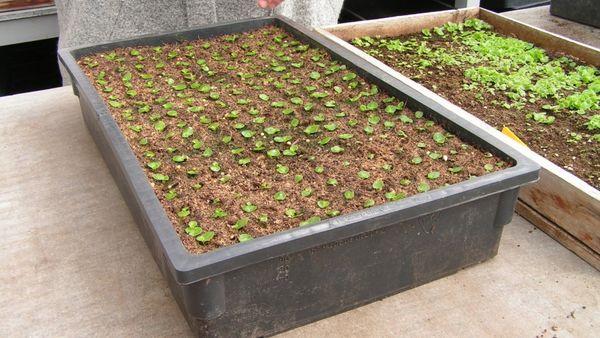
Gardening Secrets for Lush Bloom
In order for begonia to decorate the flower bed, to please with many buds, the plant needs to be regularly fed with complex fertilizer, to pick off dried leaves, to irrigate in time, but not to overflow, to prevent diseases, and protect from pests. Care must be taken that the land under the exotic flower is not covered with buds or petals, as this is fraught with the development of rot.
Gardeners recommend watering a tropical guest not only with mineral and soft water, but also with infusions made from onion husks, garlic shoots.
The flowers begin to crumble with excess moisture and high temperature. In this case, you need to shade the begonia, reduce the frequency of irrigation. When optimal conditions are created, the buds do not fall off, and the plant is covered with white, pink and scarlet flower caps.

